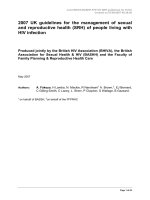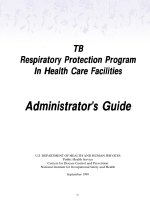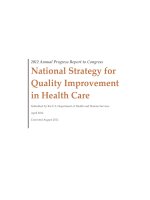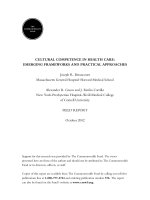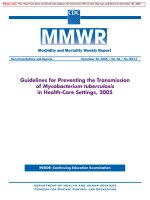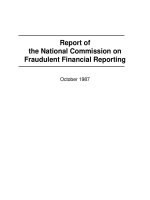The National Council on Interpreting in Health Care
Bạn đang xem bản rút gọn của tài liệu. Xem và tải ngay bản đầy đủ của tài liệu tại đây (306.48 KB, 24 trang )
MODELS FOR THE PROVISION OF
LANGUAGE ACCESS
IN HEALTH CARE SETTINGS
by
Bruce Downing, Ph.D., and Cynthia E. Roat, MPH
The National Council on Interpreting in Health Care
This paper was produced under a contract between
Hablamos Juntos and
the National Council on Interpreting in Health Care (NCIHC).
.
The National Council on Interpreting in Health Care
Acknowledgements
This paper, Models for the Provision of Language Access in Health Care Settings, was written
by Bruce Downing, PhD and Cynthia E. Roat, MPH with input from some members of the
NCIHC Board. It was reviewed and approved by the Board of Directors in January 2002.
NCIHC Board of Directors
Shiva Bidar-Sielaff, M.A., co-chair of the Board
Cynthia E. Roat, M.P.H., co-chair of the Board
Cornelia Brown, Ph.D., Chair of the Advisory Committee
Elaine Quinn, R.N., M.B.A., C.S.T, D.S.A., Treasurer
Wilma Alvarado-Little, M.A., Secretary
Karin Ruschke, M.A., co-chair: Standards, Training and Certification Committee
Linda Haffner, Interpreter/Translator, co-chair: Standards, Training and Certification
Committee
Charles C. (Mike) Anderson, M.P.A., co-chair: Research and Policy Committee
Elizabeth Jacobs, M.D., co-chair: Research and Policy Committee
Maria Michalczyk, R.N., M.A., co-chair: Organizational Development Committee
Joy Connell, co-chair: Organizational Development Committee
Julie Burns, M.Ed., co-chair: Membership and Outreach Committee
Models for the Provision of Language Access in Health Care Settings
•
March 2002
2
INTRODUCTION
Scope and Purpose
The aim of this paper is to describe various approaches that have been taken or could be taken to
avoid the linguistic incompatibility that impedes full and equal access to health care on the part
of health care providers and their patients when they do not speak the same language.
1, 2, 3, 4, 5
For present purposes, we will assume that the common language of health care delivery is
English, and that the language of the non-English-speaking individuals who seek health care is
principally Spanish. Language access in settings other than health care will not be considered.
Approach
To maintain a focus on description and comparison of models, rather than evaluation or ranking
of approaches, the paper is organized by categorizing the logically possible approaches into
broad models of linguistic accommodation of which the more specific models are presented as
subcategories. These individual models will be defined and discussed in terms of their inherent
advantages and disadvantages. For each model, an effort is made not to focus on the
shortcomings or successes of any actual implementations of a model, but rather on inherent
characteristics of the model itself. Nevertheless, this paper also addresses practical limitations
that may render a model inappropriate for some or even all practical applications.
The fundamental importance of language proficiency, interpreting skills and cultural
competence.
Despite the variety of approaches to be described, one unavoidable element is common to all
successful models of communication in health care. It is taken as given that communication and
understanding between provider and patient are essential to the successful provision of health
care. For this essential communication to take place, the two parties must share a common
language. Regardless of differences in accent or dialect, range of vocabulary and levels of
medical knowledge, the parties must be able to express themselves and understand each other
sufficiently to arrive at mutual understanding. This means that when a bilingual provider
communicates directly with a Spanish-speaking patient in Spanish, the provider must have a high
level of competence in that language. It also means that Spanish-speaking patients should be
expected to communicate their needs in English only if they have an adequate facility in English.
Finally, it means that anyone serving as interpreter must be able to communicate adequately both
in English, when speaking to an English-speaking provider, and in Spanish, when speaking with
a Spanish-speaking patient or family member. This requirement holds whether the interpreter is a
friend of the patient, an employee acting as interpreter, or a full-time staff interpreter. In the
health care setting, linguistic competence in each language must include a strong command of
health care vocabulary and the equivalence (or non-equivalence) of terms and concepts across
languages. Otherwise, the aim of providing unimpeded access to health care will be
compromised.
When the model includes the use of a linguistic intermediary – an interpreter – the requisite
linguistic competence includes a set of skills specific to interpreting, including memory and
note-taking skills, language transposition skills, etc., that go well beyond mere proficiency in
speaking the languages in question. While language skills may be learned at home, in society or
Models for the Provision of Language Access in Health Care Settings
•
March 2002
3
through a general education, interpreting skills are primarily gained through specific training and
are rarely developed through simple experience.
Finally, language and culture are inseparable. A patient and a provider who speak different
primary languages will of necessity be of different cultures. Even patients and providers who do
speak the same language may not share a cultural background. As a result, both providers and
interpreters must be aware of the role that culture plays in communication and in health-related
knowledge, attitudes and behavior, so that messages can be accurately rendered and
comprehended in their own cultural context.
Any model of interlingual communication can be successful only to the extent that these basic
skill requirements are satisfied.
6
The necessity of multiple, complementary approaches
In this paper, a number of models are distinguished and described individually. In practice,
however, in most if not all settings, a combination of models constituting a “multifaceted model”
provides the best solution for eliminating linguistic barriers to health care. Even where most
providers speak Spanish well enough to communicate in Spanish with their patients, interpreters
will be needed when a patient must speak with a technician, admissions clerk, or replacement
provider who speaks only English. Even when a hospital or clinic has dedicated interpreters on
staff, a list of on-call interpreters may be needed to serve at times of high demand, after hours,
etc. Telephonic interpreting may be needed when a provider communicates with a patient by
phone even if face-to-face interpreters are generally preferred and available. It may be
appropriate in some circumstances to rely on bilinguals engaged by the patient to interpret, but
the use of such ad-hoc interpreters is risky unless interpreters with proven qualifications are
available to monitor and if necessary replace the ad-hoc interpreter. The Spanish-English staff
interpreter may need to be assisted by a Zapotec-Spanish interpreter when the patient speaks
Spanish only haltingly, as his or her second language.
The models presented here as alternatives will therefore often need to be employed not as
exclusive alternatives but as complementary parts of a comprehensive and flexible system
facilitating communication between representatives of a health care system which predominately
uses English and any patient whose language of preference is one other than English.
This paper will not distinguish face-to-face from telephonic interpreting as models. Rather they
are seen as crosscutting means of implementing any of the models that require interpreting
services. However, since telephonic interpreting and even video interpreting are becoming more
popular, a short discussion of the implications of introducing such technology is included.
In what follows we will consider several models for communication in health care with LEP
patients. Each model will be described and then discussed in terms of its inherent advantages and
disadvantages and the circumstances in which the model seems most appropriate and most likely
to succeed.
Models for the Provision of Language Access in Health Care Settings
•
March 2002
4
BILINGUAL PROVIDER MODELS
The ideal situation for any communication is one in which the parties are able to communicate
directly with one another in a language that each speaks proficiently. In the U.S., English-
speaking providers serve English-speaking patients in English. Ideally, also, Spanish-speaking
providers and Spanish-speaking patients should be able to converse directly in Spanish. In this
model, health care providers communicate directly with their patients in the patient’s language,
and written materials are likewise available in a language the literate patient readily understands.
In such a setting, interpreters are unnecessary.
It is useful to distinguish two variants of this bilingual workforce model. (Other “work-force”
models, one in which bilingual staff members interpret for others as needed, and one in which
dedicated interpreters are employed as part of the workforce, are discussed separately below.)
Native Spanish-speakers as providers speaking Spanish
In this model the workforce is made up of bilinguals able to speak English in their contacts with
the English-speaking world and Spanish in their contacts with Spanish-speaking patients and
their families. The bilinguals speak Spanish by virtue of their ethnic heritage or national origin.
This model has several advantages. Most importantly, it satisfies the communicative ideal: health
care services offered by providers able to communicate with each patient in the patient’s
language. It entails no interpreter costs and may require no special training programs. It
approximates the services provided to English-speaking patients by English-speaking providers.
There are some disadvantages inherent in the model, however. Health care providers working in
the U.S. must be proficient in English in order to function professionally in an English-dominant
society. Many if not most of the books, articles, instructions, and charts, etc., that they read are in
English. Often they received their professional education in English. Unless they have worked
professionally in Spanish-speaking health care settings or received special training, their
knowledge of Spanish may be limited to non-professional domains, such as family and
community. They may be able to express their professional knowledge of health care better in
English than in Spanish but to socialize more comfortably in Spanish than in English. In order to
interact with patients in Spanish within the professional domain, they may need to work on
developing the professional register of medical Spanish. In addition, their general proficiency in
Spanish, their knowledge of dialects other than their own, etc. may be inadequate without special
efforts devoted to extending their linguistic repertoire.
7
There are some limitations on the venues in which such a model for language access will be
effective. A Spanish-speaking doctor in private practice can insist that the nurse and the
receptionist working in his or her office also speak Spanish. But in most communities in the
U.S., it would be difficult or impossible to staff a large clinic or hospital entirely with individuals
who are proficient enough in Spanish to provide all patient services in Spanish. Even if the
medical and nursing staff is made up of Spanish-speakers, patients are likely to have contact with
orderlies, scheduling clerks, lab technicians, or pharmacists who speak only English. For this
reason, dependence on Spanish-speaking providers must often be complemented by the use of
Models for the Provision of Language Access in Health Care Settings
•
March 2002
5
interpreters. When the clinic or hospital serves multiple language groups, it becomes virtually
impossible to guarantee that providers of all services will be able to speak all the languages
required and so, again, other models must be used as well.
Native English-speakers providing services in Spanish
Like the previous model, this one focuses on providers communicating with Spanish-speaking
patients in Spanish, without the need for interpreters. It emphasizes language instruction for
providers (or future providers) who are not already proficient in Spanish, with the aim that all
staff members will become bilingual and thus able to serve patients in their native language.
This model is again designed to promote the ideal of direct communication with patients in the
patients’ language, avoiding the need for interpreters. It goes beyond reliance on providers with
native command of Spanish by promoting the idea that any health care provider, regardless of
native language, can develop the capacity to serve Spanish-speaking clients in Spanish. Costs in
this model are centered on the preparation and continuing development of the language skills of
those who are or will become providers rather than the cost of developing interpreters and the
ongoing cost of interpreter services. Essentially, one-time educational costs replace the expense
of maintaining an interpreter service, while patients are better served through direct
communication in their language.
Unfortunately, learning to speak a second language proficiently is a long and time-consuming
process. Some individuals, regardless of their intellectual capacity or level of education, have
little aptitude for language learning. Even for those with linguistic aptitude, classroom language
instruction is poorly suited to developing the cultural understanding that must accompany
language skills in order for real communication to take place. Even an undergraduate major in
Spanish is generally insufficient for an individual to achieve the requisite native-like
competence. A lengthy residence in a Spanish-speaking environment, along with formal
language study, might be adequate preparation, but this is costly and may be impractical as a
requirement for everyone who deals directly with patients, from doctors to lab technicians,
pharmacists, nursing assistants, and clerical staff. Less extensive instruction in Spanish is
valuable for anyone who serves Spanish-speaking patients, if only to enhance rapport and respect
for the patients and their culture, but “a little Spanish” will not generally enable a doctor to take
patient histories, or obtain informed consent, or discuss the pros and cons of treatment
alternatives in the Spanish language.
8
Before it is possible to expect most or all providers of health care services to communicate with
their patients in Spanish, it may be necessary for American education to require the mastery of a
second language as a normal part of education for all citizens, just as, for example, mastery of
English or some other foreign language is expected of educated adults in Sweden, Germany and
many other countries.
Under what circumstances can this model succeed then? This model offers a possible long-term
solution to problems in providing health care access to Spanish-speakers, and in the short-term
can may increase the number of providers able to communicate without the help of interpreters.
Heavy reliance on this model, however, may require widespread, long-term systematic changes
in the preparation of health professionals and perhaps in American education generally.
Models for the Provision of Language Access in Health Care Settings
•
March 2002
6
Training in medical Spanish, extended visits to Spanish-speaking countries, and courses on
cultural health care beliefs and practices of Hispanic communities are always valuable, even for
providers who must rely on interpreters. Targeted language training may bring individuals who
already have a strong base of knowledge of Spanish to a level where they can communicate
without an interpreter in at least some situations.
THE BILINGUAL PATIENT MODEL
(The ESL Approach)
This model focuses on developing the capacity of patients to speak English, in order to express
themselves and communicate with health-care providers in the dominant language of the health-
care establishment and of the country in which they reside.
Like the previous models, this model aims for direct communication between providers and
patients, making interpreters unnecessary. Given the dominance of English for most public
purposes in the U. S., it seems desirable for all residents of the country to be able to
communicate in English, not only in seeking health care but also in many domains of life. If
Spanish-speaking individuals become bilingual in Spanish and English at a sufficiently high
level, they will be able not only to communicate readily with any health-care provider but also to
enjoy all the other benefits of speaking English in an English-dominant country.
However, while the American educational system is geared toward English language
proficiency, and adult education courses in English are widely available, the system cannot make
proficient English-speakers of the large number of Spanish-speakers who are recent immigrants
from other countries or who have not been able to complete their educations in English-medium
schools. Language mastery is time-consuming and often highly demanding for adult learners,
and the difficulty increases with age. Many Spanish-speakers live in environments that provide
little day-to-day contact with English-speakers. Existing English as a Second Language (ESL)
programs for adults generally emphasize practical communication for survival and employment,
but do not develop the higher-level language skills one needs to understand explanations of
diseases and bodily processes or treatment alternatives. Adults who have families to support and
care for generally do not have the time or the means necessary to develop mastery of a second
language.
9
As a long-term strategy, any effort to help Spanish-speaking residents of the U. S. develop their
ability to communicate in English is clearly worthwhile. However, for older adults who do not
already speak English well and especially for recent immigrants, this language-learning model,
by itself, does not solve the immediate problem of communicating in health care settings for
those who have not yet mastered English or are unable, for whatever reasons, to do so.
Clearly, instruction in medical English can be valuable for those who already have a basic
understanding of English. However, individuals who need to develop their English in this area
also need to develop other aspects of English proficiency for other purposes; they cannot afford
to devote all their efforts to learning the register of the health care domain.
Models for the Provision of Language Access in Health Care Settings
•
March 2002
7
INTERPRETER MODELS
The third major category of approaches to providing language access is the interpreter models. If
the provider cannot be taught to speak the language of the patient, and if the patient cannot be
taught to speak the language of the provider, the only recourse is to engage a third party who
speaks both languages to act as interpreter. We divide the interpreter models into two main
groups: the ad-hoc models and the dedicated interpreter models.
Ad-hoc models
Ad-hoc models of interpreting depend on individuals whose main function in the health care
setting is something other than interpreting. These individuals may work within health care or
outside it. They provide interpreting services as a secondary function to their principal job.
10
Bilingual Clinical Staff Model
This model depends on bilingual clinical staff, such as physicians, PAs, ARNPs, nurses,
technicians etc. to provide interpreting services for patients being seen by other providers. They
generally interpret in the same clinic or specialty area in which they provide their professional
services and most often are asked to interpret as the need arises, without previous notice.
The advantages of this model lie in the immediate availability of the ‘interpreter’ and his or her
knowledge of health care concepts and medical terminology, at least in English. Administrators
may also perceive that interpreting is being provided at no additional cost to the institution.
The disadvantages of this model, however, are numerous. Primary among them and common to
all ad-hoc models is that clinical staff members are rarely trained to interpret and so are likely to
be ignorant of the ethics and techniques so essential to quality interpreting. While clinical staff
members trained in the U.S. may be familiar with health care concepts in English, they are, as a
rule, unfamiliar with the same terminology in their other language. It may be very difficult for
patients to understand when this bilingual clinical staff person is acting in his or her professional
role and when he or she is acting as an interpreter. This confusion of roles often leads the patient
to speak to the ‘interpreter’ rather than to the provider that the ‘interpreter’ is supposed to be
assisting, undermining the patient-provider relationship. Because these bilingual staff members
have other professions, they often do not think of themselves as interpreters and very rarely
strive to improve their interpreting skills or participate in continuing education in the field.
Finally, being pulled from other duties to interpret lowers their productivity in the job for which
they were hired, and with higher per-hour compensation rates, clinical staff make for very
expensive interpreters.
For these reasons, using bilingual clinical staff to interpret is a questionable use of these highly
trained individuals and is likely to result in poor-quality interpreting and confusion for the
patient. In addition, in clinics with a variety of language needs, it would be very difficult to have
enough bilingual staff to cover all the needs. To successfully employ this model, it is imperative
to assure that the staff being asked to interpret meet the same criteria as any interpreter:
demonstrated linguistic proficiency; training in health care interpreting ethics and techniques;
Models for the Provision of Language Access in Health Care Settings
•
March 2002
8
interpreting competency; and participation in continuing education for interpreters. In this way,
at least some of the disadvantages of this model can be ameliorated.
Bilingual Non-Clinical Staff model
Related to the previous model and probably more common is the use of bilingual non-clinical
staff to interpret.
11
This includes receptionists, medical assistants, janitorial and food services
staff, and any clinic staff members who are asked to interpret outside their area of expertise. In
this model, bilingual staff members are commonly asked to interpret anywhere within the
medical facility on short notice. In most cases, bilingual staff members are not paid extra for this
service.
The advantages of this model include rapid access to individuals who can be called upon to act
as ‘interpreters.’ Like the previous model, this model is often perceived by administrators as an
efficient use of bilingual personnel to provide language access at no extra cost to the institution.
The drawbacks to this model include some that impact interpreting and some that impact the
functioning of the institution. Like bilingual clinical staff, non-clinical staff members usually
have no training as interpreters. And unlike clinical staff, these individuals rarely have a working
knowledge of health care issues and vocabulary in either of their languages. Unless special
training is offered, these two attributes together usually lead to very poor quality interpreting. On
the institutional side, pulling bilingual staff members from their regular work interrupts clinic
functioning and often causes dissatisfaction among colleagues who must cover for the absent
worker. Productivity is likely to go down. Anecdotal evidence suggests that bilingual staff
members required to interpret often have very high turnover rates, incurring additional hidden
costs for the institution.
12
While this is one of the most widespread models currently in use in the U.S., in practice it has
suffered from the drawbacks mentioned above and has been attempted mainly in institutions that
serve one primary LEP group. For this model to be implemented effectively, staff members need
to have their language skills screened and to be trained and assessed as interpreters. In addition,
strong support needs to be developed among mid-level managers and line staff so that bilingual
staff will not suffer from unwarranted consequences when called away to interpret. Some
institutions have established an “Interpreter for a Day” program in which bilingual staff spend
one day a week interpreting only. Others have instituted pay differentials for bilingual staff
called to interpret, in recognition of the additional responsibilities and the training and skills
those responsibilities require. Again, this model works best in clinics serving one primary LEP
language group and where the non-clinical staff includes many who are highly proficient in two
languages.
Community Service Agency staff model
In many cities around the country, community service agencies have taken on the responsibility
of providing interpreters free of charge to accompany their clients to medical and social service
appointments. Catholic Charities, Lutheran Social Services and other refugee resettlement
agencies are among those who provide this service in many cities as a means of guaranteeing
access for their clientele. In this model, the community service agency provides a bilingual staff
Models for the Provision of Language Access in Health Care Settings
•
March 2002
9

